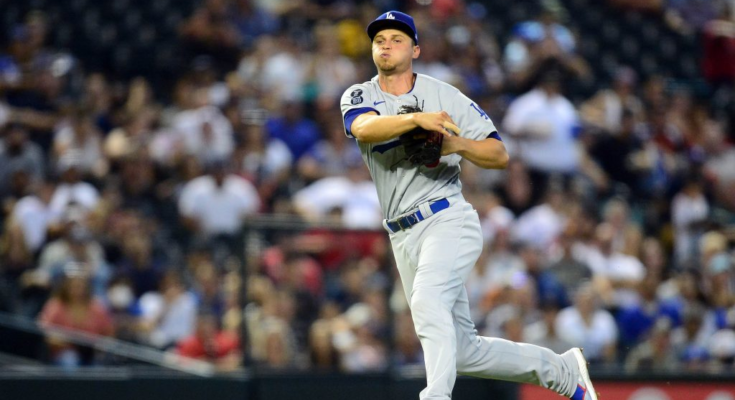Corey Seager’s 10-year, $325MM deal with the Rangers prior to the MLB lockout shocked baseball — both because it was the Rangers winning the bidding and because Texas had already signed Marcus Semien for a surprising seven years and $175MM. As one would expect with any bidding war that reaches a decade and more than $300MM, Texas had some competition as they sought to lure Seager to Arlington. However, ESPN’s Jeff Passan reports this morning that a perhaps-unexpected suitor was one of the primary competitors in that Seager market: the Blue Jays.
The Dodgers also had strong interest in re-signing Seager, per Passan, though that much was largely known to this point. Toronto’s involvement in the process, however, is a newer revelation. The Jays were known to be attempting to re-sign Semien, but Seager’s contract was in an entirely different financial stratosphere. Ultimately, Toronto simply wasn’t willing to match Texas’ 10-year, $325MM terms, but Passan suggests that the team was “very much” in on Seager prior to his deal with Texas.
That’s of some anecdotal note and makes for a fine “what-if” moment for Jays fans down the line, but it’s also informative of the team’s current mindset and simultaneously instructive of how the Jays will be able to operate post-transaction freeze. The Blue Jays have just shy of $97MM committed to the septet of George Springer, Kevin Gausman, Hyun Jin Ryu, Jose Berrios, Randal Grichuk, Lourdes Gurriel Jr. and Yimi Garcia. Add in a steep arbitration class headlined by burgeoning star Vladimir Guerrero Jr., and the Jays have another $31MM or so in projected payroll, according to MLBTR contributor Matt Swartz.
That brings the Jays to nearly $128MM in 2022 projections — plus another nine pre-arbitration salaries (generally in the vicinity of the league minimum). For a team that opened the 2021 season with about $135MM in guaranteed salary and has previously pushed payroll to $163MM, it’s not really a shock to see that there’s more room in the 2022 budget. However, signing Seager would’ve been about far more than 2022 dollars.
For Toronto, signing Seager would’ve meant had four sizable, fully guaranteed contracts on the books as far out into the future as 2026, when Springer, Gausman and Berrios are all still under contract. (Berrios is signed through 2028, though his contract contains an opt-out after that ’26 campaign.) Any Seager signing would’ve figured to include a salary north of $30MM being added onto that 2026 ledger, meaning the Jays were essentially comfortable with the idea of committing $93MM or more to four players in 2026 — about a half-decade in advance.
With Toronto also surely keen on extending both Guerrero and Bo Bichette at some point, any serious level of interest in Seager is all the more notable. The 2026 season is the first would-be free-agent year for both Guerrero and Bichette, so throwing a Seager contract onto the pile indicates a willingness to spend well above nine figures on 2026 payroll if there’s to be any hope of realistically extending either young star.
It’s all an exercise in hindsight, to an extent, as Seager is of course set to spend the next decade as a Ranger. But the Jays’ apparent willingness to jump into the Seager market also provides some useful context when looking at how they’ll operate once transactions resume under a new collective bargaining agreement.
Perhaps Toronto simply viewed Seager as an exception and was comfortable spending that type of money singularly on Seager and Seager alone. However, the market has several high-end free agents who remain unsigned and will be in position to command sizable long-term deals. Carlos Correa could well land a deal in the same range as Seager commanded. Trevor Story figures to be eyeing a nine-figure commitment, perhaps over a shorter term that caps off around that same 2026 point the Jays’ current commitments come to an end. The Jays have already been tied to star NPB outfielder Seiya Suzuki, and the outfield market also includes higher-profile names like Kris Bryant, Nick Castellanos and Kyle Schwarber.
Toronto certainly isn’t under any obligation to tack another nine-figure deal onto the books, but the mere fact that they were a player of any real note in the Seager bidding shows that they can’t be squarely ruled out from doing so. Another major free-agent expenditure would make for enormous major payrolls down the road when Guerrero and Bichette are in their final couple years of arbitration (and/or into the free-agent portions of theoretical extensions), but the Jays are committed to winning right now. Even with three long-term deals on the books and a pair of high-profile young stars they’ll hope to extend, we shouldn’t assume Toronto will shy away from another major long-term deal.


